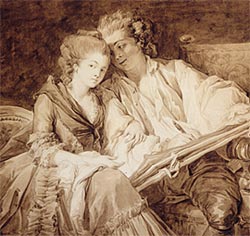
Private Treasures provides the public the rare opportunity to view works from the sixteenth through the twentieth centuries drawn entirely from an esteemed private collection. The exhibition features many drawings from the Italian school, such as Agnolo Bronzino's exceptional Study of the Dead Christ. Further highlights include a double-sided sheet of studies by Correggio for his decoration of the cupola of S. Giovanni Evangelista in Parma as well as works from the Roman High Baroque by Pietro da Cortona and Bernini and by eighteenth-century Venetian artists Giambattista and Giandomenico Tiepolo.
French drawings from the seventeenth through nineteenth centuries are also well represented. Antoine Watteau's spectacular drawing of a Man Playing a Guitar, illustrative of an artist's rapid and immediate notations, is shown alongside Vincent's Drawing Lesson, which is replete with amorous undertones and constitutes a highly finished work. A landscape by the seventeenth-century master of pastoral scenes, Claude Lorrain, was one of several drawings by French artists active in Rome. The eighteenth century was represented by artists such as Jean-Honoré Fragonard and Hubert Robert and the nineteenth century by Odilon Redon and Edgar Degas.
Among works by British artists, there are a freely drawn landscape by Thomas Gainsborough and John Constable's oil sketch of the sea-shore at Brighton. A luminous view of an Amsterdam street by the eighteenth-century artist Jacob Cats is one of several sheets from the Dutch school. The German Romantic artist Caspar David Friedrich is represented by an evocative moonlit landscape. The selection concludes with works by Adolf von Menzel and powerful self-portraits by Käthe Kollwitz and Lovis Corinth.
Private Treasures is on view at the National Gallery of Art, Washington, May 6 through September 16, 2007.
François-André Vincent (French, 1746–1816)
The Drawing Lesson, 1777, (detail)
Brush and brown wash over graphite
12 13/16 x 14 13/16 inches (325 x 377 mm)
Private collection
